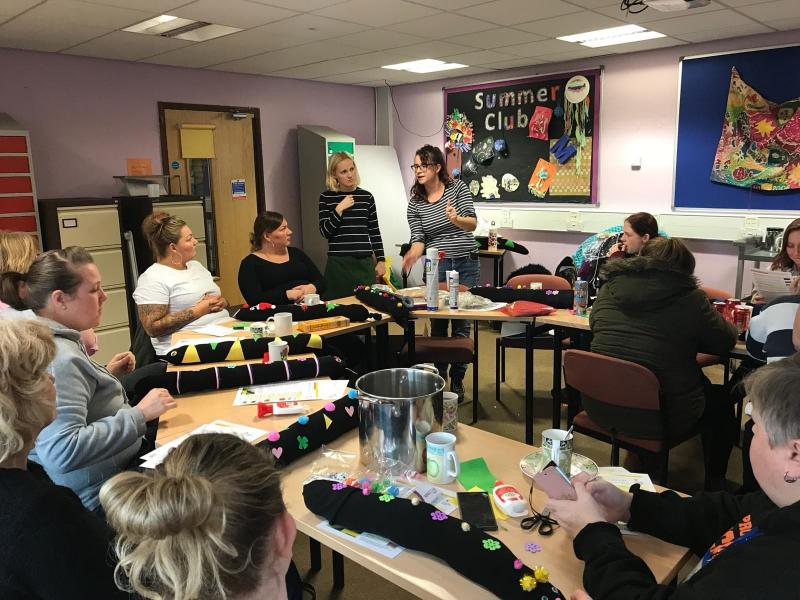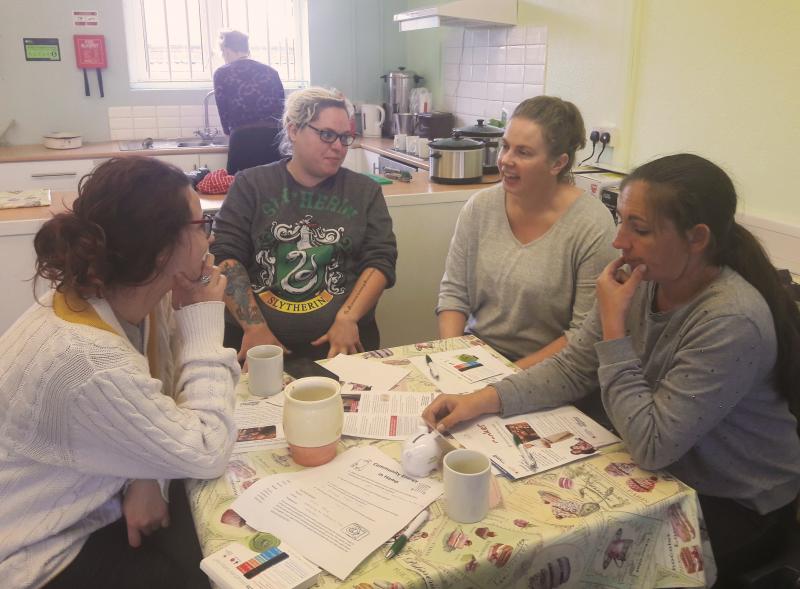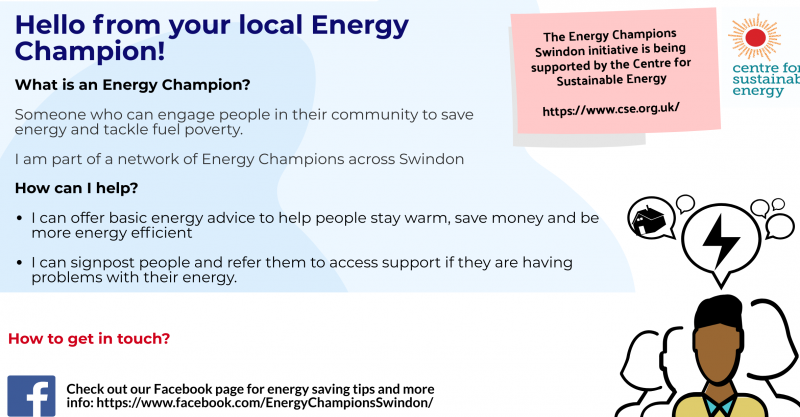Joanna Watson28 Jun 2021
Energy can be boring. Many people don’t find it exciting or interesting, unless they have the means to invest in it – like solar PV on their roofs, or heat pumps in their houses, or have bought an electric car. Less affluent households have much less opportunity to act - they use energy in their homes, and often struggle to pay their bills, but it’s not something that they think about engaging in collectively. At the same time energy is essential - and reducing inequality of access to affordable green energy is key to building community resilience.
So what happened when the Centre for Sustainable Energy developed the Powering Up project to empower low-income communities to take more control over the energy they use? And what can we learn about how to support communities to take action for the climate?
What is Powering Up?
It’s a project about engaging with local people to develop energy efficiency strategies in low-income communities. Harriet and her colleagues from the Centre for Sustainable Energy wanted to test approaches to initiating grassroots action on energy - in ways that were empowering, led by residents and would help build skills and capacity locally.
They’ve had varying degrees of success and it's been a long journey to some positive outcomes.
But the important thing about the way the process was set up is that it enabled them to learn and pivot, because their funder, Friends Provident Foundation, saw Powering Up as a learning project – rather than delivering against targets. “We were given the freedom to run this without pressure” says Harriet which meant reflective practice was much easier. The team tried out lots of different things and some really valuable insights emerged.
Capturing the insights
The CSE team started with 3 communities – Penhill in Swindon, Dyffryn in South Wales and Bridgwater in Somerset and planned to do in-depth interviews from 3 households in each locality. They hoped that finding out about people’s understanding of energy and identifying their needs would create a good foundation for community engagement in the project. This was their first lesson.
Lesson 1: You can't do this properly if you're not locally based.
The team was not locally-based and was stretched across three communities. To build something with roots from nothing you need a daily presence, to be out and about every day. You need to get recognised, become known and build trust. In Swindon and Bridgwater the team identified people to talk to via the local council housing and community development officer. In Dyffryn they employed someone through the local community hub in an effort to overcome these barriers.
This local collaboration enabled inroads and partnership building. But on reflection the project team feel these local organisations and stakeholders would have been far more invested had they been involved in the original task of defining the project and applying for funding.
Lesson 2: Without the power to act, energy efficiency isn't a priority.
In low-income communities energy isn't something people feel very empowered to engage with proactively, either in their own home or with other community members. They felt that improving how well their home retains heat is predominantly the landlord’s responsibility, not theirs – or the council’s, if they live in social housing. The project team learnt that many households also felt they had already done as much as they could as individuals. While some residents were sufficiently interested to attend events, there was little momentum to take things forward in between - it simply wasn’t a priority. And if you don’t think you have the power to act, you’re unlikely to invest time in thinking about solutions.
Lesson 3: You need a clear project definition.
Harriet admits to being rather naïve. They were trying to be open, to listen and build activities together. “We wanted to chat to householders, find out about their energy issues and what activities they would like to do together”.
But in the context where people are more used to initiatives or projects that are pre-defined, and service-like in nature, people struggled with the approach. Asking local people to get involved with and co-create an undefined project was not a way of working they were used to. Householders were being asked "what would you like to do?" but they didn’t understand what the project was and couldn’t identify with it.
You need to suit your project to the local context and demographics, modifying it when you recognise it’s not landing as you expect.
Lesson 4: Don't put the onus on the community too early.
So the CSE team took a different tack and started to deliver training sessions and engagement activities. “Of course, we should have started here but realising that was part of the learning process” reflects Harriet. They began to get more interest from a few individuals who got it and were up for being involved. It was slow. Many attempts - talks in Bridgwater with a local college, engaging with community associations, plans to collaborate with youth workers – came to a dead end, but when the team focused on building capacity to deliver energy advice, they found 3 individuals in Swindon interested in taking things forward.
Lesson 5: Concentrate your resources and find your ambassadors who are already community connectors.
Don’t be downhearted if you haven’t engaged large numbers of people. You need to work with trusted individuals who are already invested in their community. One woman became an informal energy champion because she could weave ideas about energy into the everyday. She's a single mum with an environmental science degree and although personally very stretched and not usually a leader she stepped up. “She is liked and chatty, a person who can chat about energy stuff as part of life”. Harriet reflects on what this taught her. “Community energy isn’t just big shiny fancy involving tech. It’s low key, small consistent, present. It’s little trickles".
The Powering Up project is about the small, the daily, the weaving into people’s lives, the little conversations. That’s where it happens.
Lesson 6: Stick with it and be prepared to pivot.
As the numbers involved have been small it’s been hard to capture impact objectively. The project increased energy awareness in those who came to events or were given advice but overall engagement was so low it didn’t seem worth putting numbers on it.
However, having decided to halt the project in Dyffryn and Bridgwater, matters took a different turn in Swindon, where some of the project’s participants have successfully engaged with stakeholders.
Despite attempts at the beginning of the project, the team had struggled to engage with Swindon Council’s community adult learning provision. However when the pandemic struck, the team decided to run an online Energy Champions programme. One of their energy champions happened to work for the council and put them in touch with the adult learning team. This resulted in the project team delivering 3 energy awareness sessions and training the council team in the process. The council is now committed to offering energy awareness as part of its community adult learning offering.
Lesson 7: Be patient - where you end up may be a long way from where you started.
The project had carried out thermal imaging surveys in Penhill in a couple of houses and presented the results to the local community in the hope of getting the ball rolling. Two of these people who helped with the survey and were involved in Swindon Climate Action Network ended up as energy champions and wanted to explore community level retrofit. Powering Up worked with Swindon Council's Affordable Warmth officer and the CHEESE project to convene a meeting with interested parties, which resulted in a motion asking the Council to support the setting up of a community interest company (CIC) to provide retrofit locally. Harriet worked with a local councillor to ensure the motion referenced the importance of focussing support on fuel-poor households and of community-based programmes like energy champions. The motion was passed and an energy champion and a retrofit expert are now working on what this CIC could look like. It’s taken a long time to push things forward but Harriet feels the council's commitment has roots and momentum.
Lesson 8: Take a multi-pronged approach.
Things happen slowly until you have the right meeting, policy agenda, or confluence of interest. Don’t abandon roads that don’t seem to be going anywhere. Keep in touch with contacts you make along the way.
When the team started Powering Up, climate breakdown and sustainable energy seemed low on the council’s agenda - and low on the government’s agenda and in the general public’s consciousness. Combined with the aftermath of austerity and the threadbare capacity of local government and the voluntary sector, this lack of interest created additional barriers. At the end it felt like there had been a real shift, at least in terms of renewed public awareness of the climate emergency and local action, although the impacts of austerity are still very real, which in turn spilled over into local and national government commitments to act.
Initially the team shied away from framing Powering Up in environmental terms, especially as these communities have a very low carbon footprint – resonant of the tension the project team sometimes felt about the project both engaging with fuel poverty and mitigating climate change. But towards the end of the project the environment and climate messaging became more important. Broader political and public shifts in attitudes also provided more "hooks" for the project - such as Swindon Council’s climate emergency declaration.
Lesson 9: Record, harvest and disseminate your learnings.
During the course of the project the team published regular blogs on what they were learning along the way. And in the final 6 months they looked at the range of their activities and created "How To" guides. With additional funding from the Joseph Rowntree Charitable Trust they are sharing these guides with other umbrella organisations (with grassroots groups), and supporting 2 further communities to build grassroots action on energy – but with greater clarity about the team's role and what they can provide.
Lesson 10: The importance of upskilling and empowering key individuals.
To get cut-through for energy efficiency and the climate crisis at local level you have to engage, empower and help people develop an understanding of the agenda and upskill individuals to become advocates. There’s a debate about whether to go wide or to go deep. Harriet’s experience with Powering Up is that it’s probably more effective to focus on a few key people active in and trusted by their community and pay and support them to take on the role of advocates. Although she caveats this conclusion – it’s dependent on what assets they have, their relationships and the way the local community works.
We look forward to hearing more as the dissemination phase of the project develops. Thank you Harriet for sharing your insights.
Please share this blog and get in touch to find out more about taking an experimental approach.





